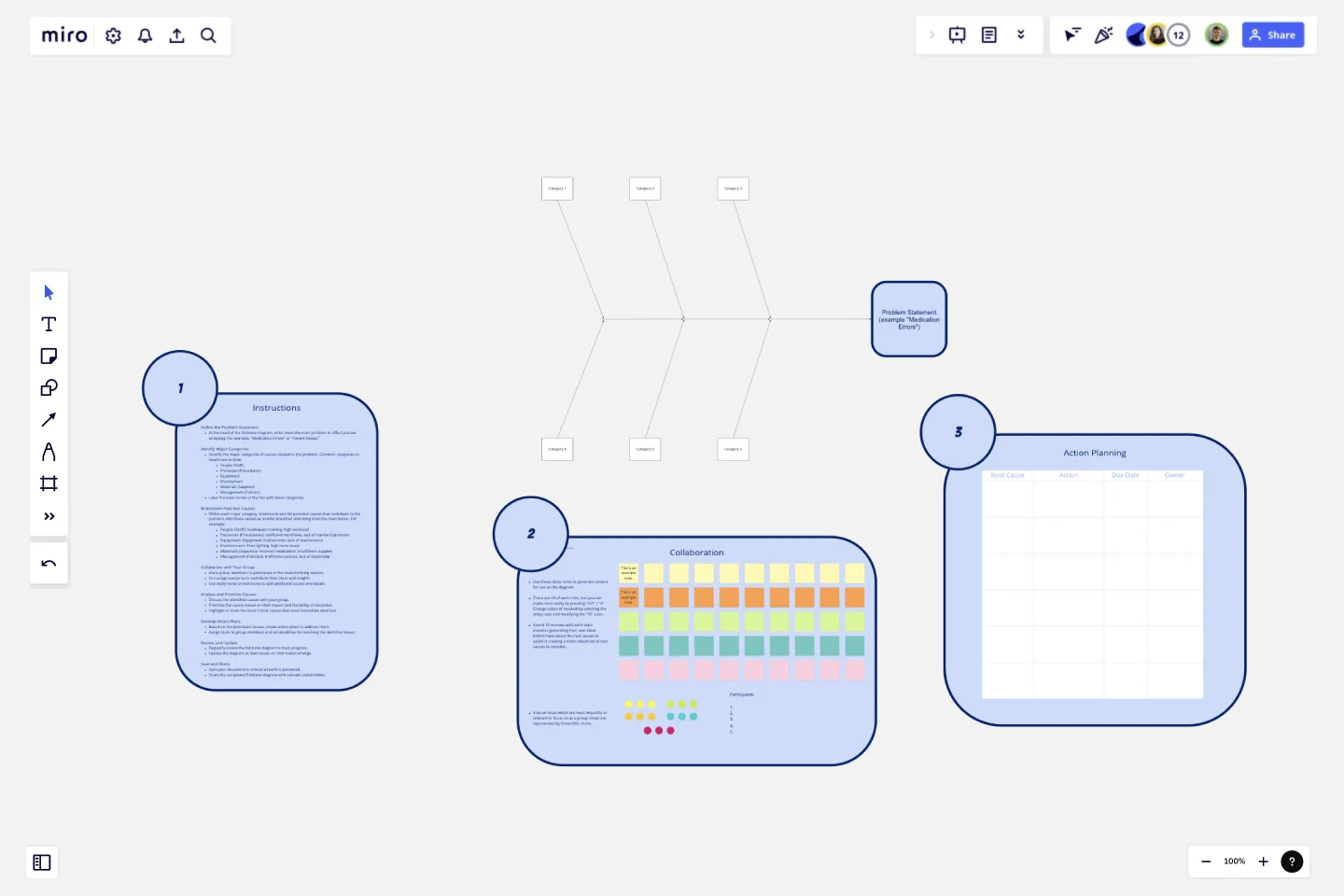Fishbone Diagram for Healthcare
The Fishbone Diagram for Healthcare template is a specialized tool designed to help healthcare teams systematically analyze and identify the root causes of issues within healthcare settings.
Here’s why you should consider using this template:
Key Features:
Problem-Centric Design:
The diagram starts with a clear definition of the problem or effect you are addressing, such as "Medication Errors" or "Patient Delays," providing a focused approach to problem-solving.
Major Categories:
The template includes predefined categories relevant to healthcare, such as People (Staff), Processes (Procedures), Equipment, Environment, Materials (Supplies), and Management (Policies). These categories help in organizing potential causes systematically.
Structured Brainstorming:
Each category has branches for listing potential causes, encouraging thorough brainstorming and ensuring that no aspect of the healthcare process is overlooked.
Collaborative Framework:
The template is designed for team collaboration, allowing multiple users to contribute their insights and ideas in a structured manner, fostering a comprehensive analysis.
Visual Clarity:
The fishbone (Ishikawa) diagram's visual structure makes it easy to understand the relationships between the problem and its potential causes, facilitating better communication and discussion among team members.
Why Use This Template?
Systematic Problem Analysis:
The Fishbone Diagram for Healthcare template helps in systematically breaking down complex healthcare problems into manageable parts, making it easier to identify root causes and areas for improvement.
Holistic View:
By considering multiple categories, the template ensures that all possible aspects of the healthcare process are examined, leading to a more thorough and comprehensive investigation.
Improved Collaboration:
The template promotes team collaboration, ensuring that diverse perspectives from different roles and departments are considered. This can lead to more innovative solutions and a better understanding of the problem.
Enhanced Decision-Making:
The structured approach of the template aids in prioritizing causes based on their impact, helping teams focus on the most critical areas first. This improves decision-making and action planning, leading to more effective interventions.
Effective Communication:
The visual nature of the fishbone diagram makes it easier to communicate findings and strategies to stakeholders, ensuring that everyone involved has a clear understanding of the issues and proposed solutions.
By using the Fishbone Diagram for Healthcare template, teams can effectively analyze healthcare-related issues, identify root causes, and develop targeted action plans to improve patient care, operational efficiency, and overall quality of service.
This template was created by Anthony.
Get started with this template right now.
Lean Canvas Template
Works best for:
Agile Methodology, Strategic Planning, Agile Workflows
Business opportunities can get dense, cumbersome, and complex, and evaluating them can be a real challenge. Let a lean canvas streamline things and break down your business idea for you and your team. A great tool or entrepreneurs and emerging businesses, this one-page business model gives you an easy, high-level view of your idea — so you can stay focused on overall strategy, identify potential threats and opportunities, and brainstorm the various factors at play in determining your potential profitability in an industry.
English Grammar Timeline Builder
The English Grammar Timeline template helps you map out the progression of grammar concepts over time. This is a great tool for educators and students to visualize the sequence and relationship between different grammar topics, making learning and teaching more effective.
5W1H Template
Works best for:
Strategy & Planning
The 5W1H Template is a strategic framework that clarifies complex situations or projects into six foundational questions: What, Who, Where, When, How, and Why. This methodological approach ensures a comprehensive understanding, encouraging teams to dissect and explore every aspect of a given challenge or project.
SIPOC Template
Works best for:
Agile Methodology, Strategic Planning, Mapping
A SIPOC diagram maps a process at a high level by identifying the potential gaps between suppliers and input specifications and between customers and output specifications. SIPOC identifies feedback and feed-forward loops between customers, suppliers, and the processes and jump-starts the team to think in terms of cause and effect.
PDCA Template
Works best for:
Planning
The PDCA template provides a visually compelling representation of the Plan-Do-Check-Act cycle, a foundational management methodology. Structured around four primary segments, this template helps teams systematically address challenges, test solutions, assess outcomes, and make necessary refinements. Using the PDCA template fosters continuous improvement. By cycling through each phase repeatedly, organizations can perpetually refine their strategies, ensuring they always move towards optimal solutions and processes.
Communication Matrix Template
Works best for:
Project Management, Project Planning, Meetings
The Communication Matrix Template serves as a structured framework for businesses and projects to streamline their communication strategies. By mapping out types of communication, their purposes, mediums, frequencies, and intended audiences, the template ensures that every stakeholder remains informed and aligned. One of its key benefits is the enhanced clarity it brings. By laying out the specifics of each communication touchpoint, the matrix eliminates ambiguity, ensuring that all involved parties know exactly what to expect and when leading to more efficient collaboration and fewer misunderstandings.
